An Analysis of Nuclear Disarmament and the North Korean Peninsula
VerifiedAdded on 2020/03/07
|9
|1921
|453
Essay
AI Summary
This essay delves into the complex issue of nuclear disarmament, using North Korea as a central case study. It begins by highlighting the challenges of achieving global nuclear disarmament and the importance of a multipolar system of nuclear deterrence. The essay examines North Korea's nuclear capabilities, which are perceived as a significant threat by its neighbors and the international community. It explores various approaches to managing this threat, including strengthening alliances, tightening sanctions, and engaging in negotiations. The essay analyzes the potential benefits and drawbacks of each option, considering the risks of escalation, the limitations of sanctions, and the challenges of negotiating with Kim Jong-un. The conclusion emphasizes the need to understand the risks associated with nuclear proliferation and to prioritize the elimination of any potential for another war on the Korean Peninsula.
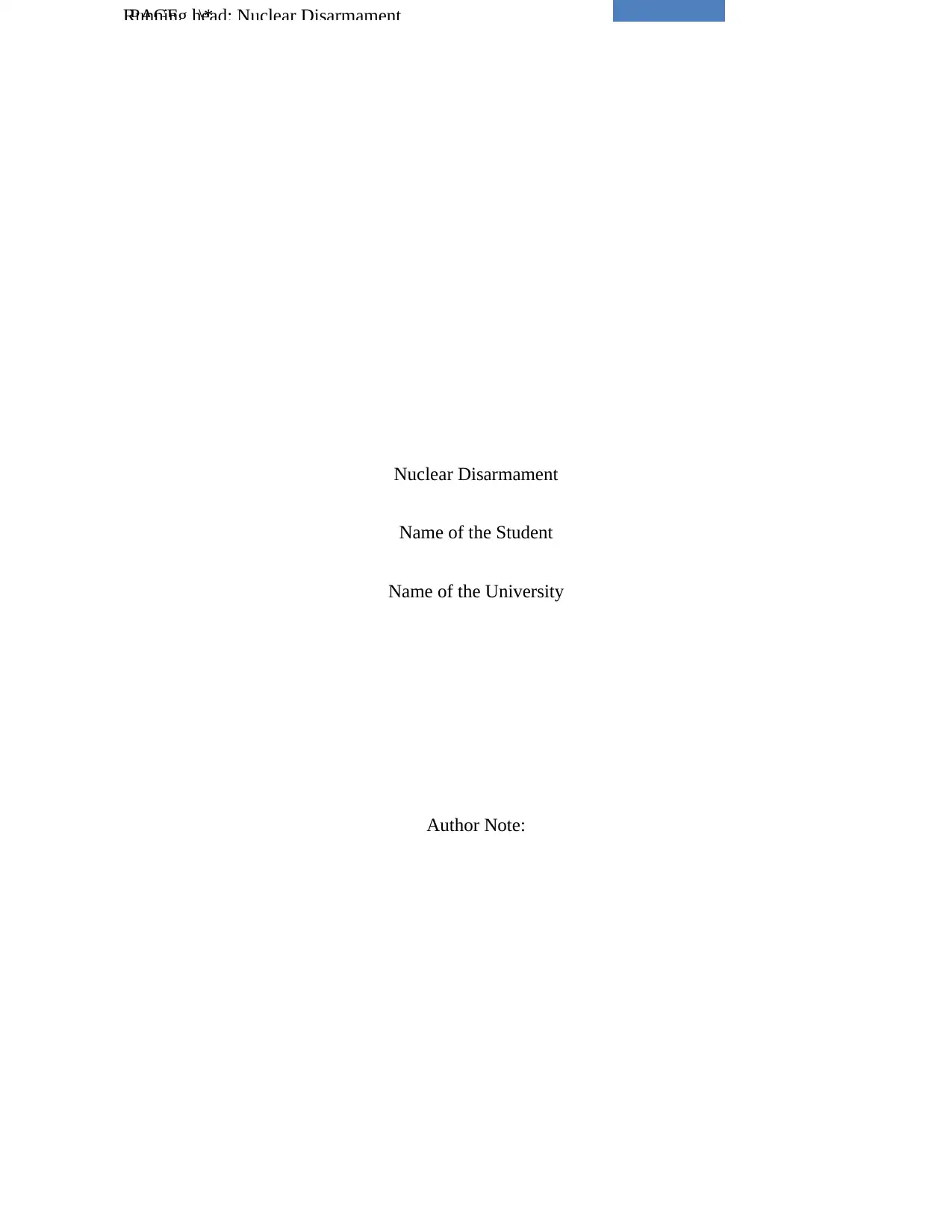
PAGE \*Running head: Nuclear Disarmament
Nuclear Disarmament
Name of the Student
Name of the University
Author Note:
Nuclear Disarmament
Name of the Student
Name of the University
Author Note:
Paraphrase This Document
Need a fresh take? Get an instant paraphrase of this document with our AI Paraphraser
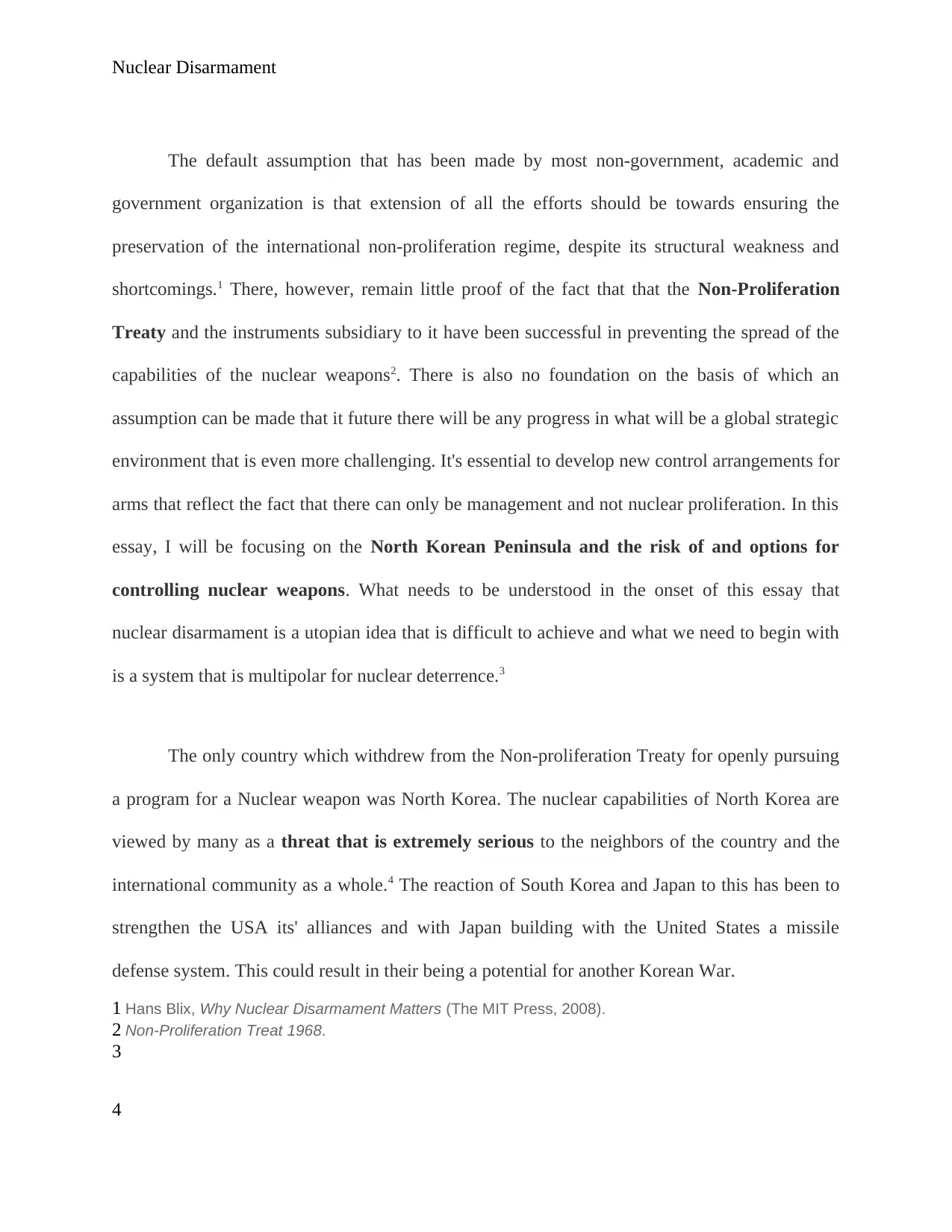
Nuclear Disarmament
The default assumption that has been made by most non-government, academic and
government organization is that extension of all the efforts should be towards ensuring the
preservation of the international non-proliferation regime, despite its structural weakness and
shortcomings.1 There, however, remain little proof of the fact that that the Non-Proliferation
Treaty and the instruments subsidiary to it have been successful in preventing the spread of the
capabilities of the nuclear weapons2. There is also no foundation on the basis of which an
assumption can be made that it future there will be any progress in what will be a global strategic
environment that is even more challenging. It's essential to develop new control arrangements for
arms that reflect the fact that there can only be management and not nuclear proliferation. In this
essay, I will be focusing on the North Korean Peninsula and the risk of and options for
controlling nuclear weapons. What needs to be understood in the onset of this essay that
nuclear disarmament is a utopian idea that is difficult to achieve and what we need to begin with
is a system that is multipolar for nuclear deterrence.3
The only country which withdrew from the Non-proliferation Treaty for openly pursuing
a program for a Nuclear weapon was North Korea. The nuclear capabilities of North Korea are
viewed by many as a threat that is extremely serious to the neighbors of the country and the
international community as a whole.4 The reaction of South Korea and Japan to this has been to
strengthen the USA its' alliances and with Japan building with the United States a missile
defense system. This could result in their being a potential for another Korean War.
1 Hans Blix, Why Nuclear Disarmament Matters (The MIT Press, 2008).
2 Non-Proliferation Treat 1968.
3
4
The default assumption that has been made by most non-government, academic and
government organization is that extension of all the efforts should be towards ensuring the
preservation of the international non-proliferation regime, despite its structural weakness and
shortcomings.1 There, however, remain little proof of the fact that that the Non-Proliferation
Treaty and the instruments subsidiary to it have been successful in preventing the spread of the
capabilities of the nuclear weapons2. There is also no foundation on the basis of which an
assumption can be made that it future there will be any progress in what will be a global strategic
environment that is even more challenging. It's essential to develop new control arrangements for
arms that reflect the fact that there can only be management and not nuclear proliferation. In this
essay, I will be focusing on the North Korean Peninsula and the risk of and options for
controlling nuclear weapons. What needs to be understood in the onset of this essay that
nuclear disarmament is a utopian idea that is difficult to achieve and what we need to begin with
is a system that is multipolar for nuclear deterrence.3
The only country which withdrew from the Non-proliferation Treaty for openly pursuing
a program for a Nuclear weapon was North Korea. The nuclear capabilities of North Korea are
viewed by many as a threat that is extremely serious to the neighbors of the country and the
international community as a whole.4 The reaction of South Korea and Japan to this has been to
strengthen the USA its' alliances and with Japan building with the United States a missile
defense system. This could result in their being a potential for another Korean War.
1 Hans Blix, Why Nuclear Disarmament Matters (The MIT Press, 2008).
2 Non-Proliferation Treat 1968.
3
4
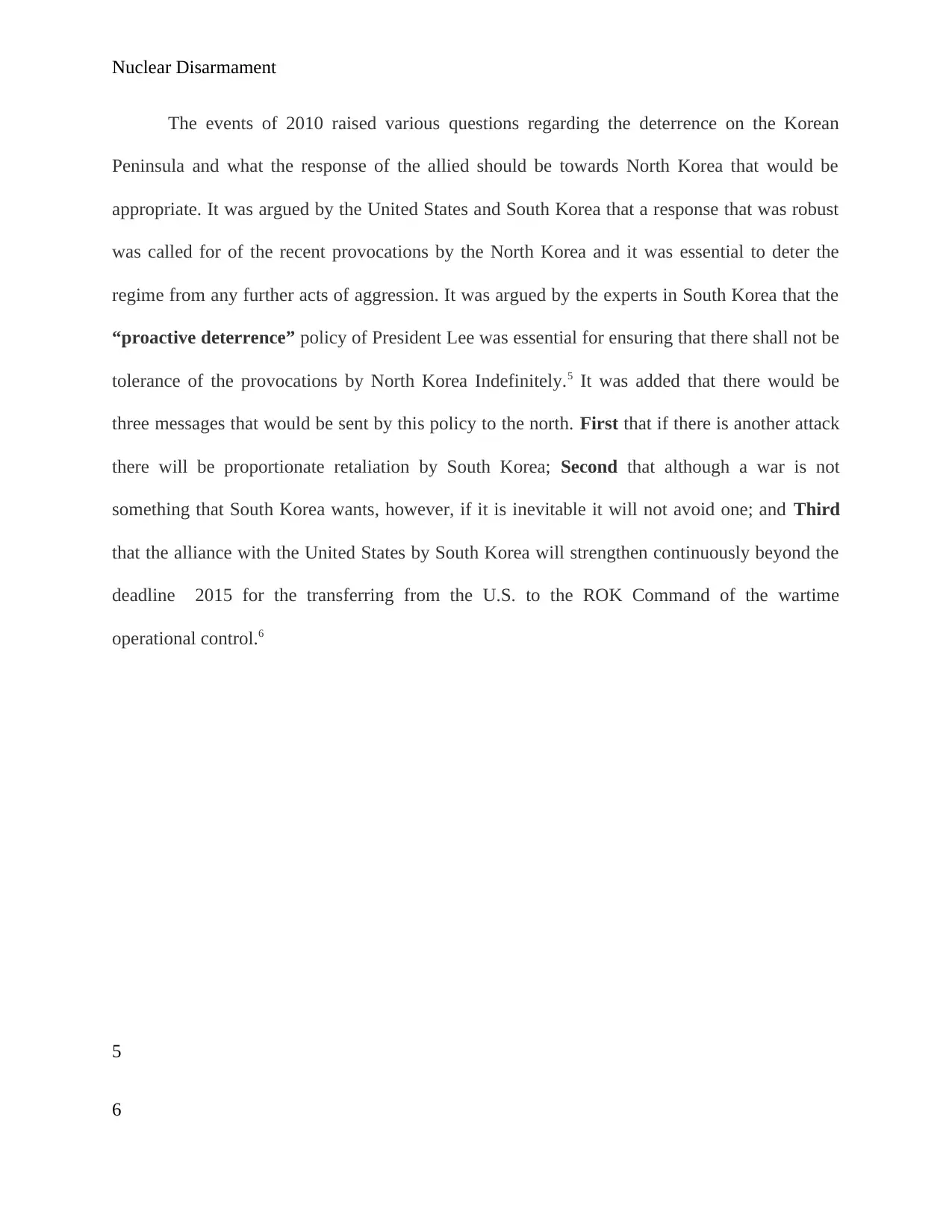
Nuclear Disarmament
The events of 2010 raised various questions regarding the deterrence on the Korean
Peninsula and what the response of the allied should be towards North Korea that would be
appropriate. It was argued by the United States and South Korea that a response that was robust
was called for of the recent provocations by the North Korea and it was essential to deter the
regime from any further acts of aggression. It was argued by the experts in South Korea that the
“proactive deterrence” policy of President Lee was essential for ensuring that there shall not be
tolerance of the provocations by North Korea Indefinitely.5 It was added that there would be
three messages that would be sent by this policy to the north. First that if there is another attack
there will be proportionate retaliation by South Korea; Second that although a war is not
something that South Korea wants, however, if it is inevitable it will not avoid one; and Third
that the alliance with the United States by South Korea will strengthen continuously beyond the
deadline 2015 for the transferring from the U.S. to the ROK Command of the wartime
operational control.6
5
6
The events of 2010 raised various questions regarding the deterrence on the Korean
Peninsula and what the response of the allied should be towards North Korea that would be
appropriate. It was argued by the United States and South Korea that a response that was robust
was called for of the recent provocations by the North Korea and it was essential to deter the
regime from any further acts of aggression. It was argued by the experts in South Korea that the
“proactive deterrence” policy of President Lee was essential for ensuring that there shall not be
tolerance of the provocations by North Korea Indefinitely.5 It was added that there would be
three messages that would be sent by this policy to the north. First that if there is another attack
there will be proportionate retaliation by South Korea; Second that although a war is not
something that South Korea wants, however, if it is inevitable it will not avoid one; and Third
that the alliance with the United States by South Korea will strengthen continuously beyond the
deadline 2015 for the transferring from the U.S. to the ROK Command of the wartime
operational control.6
5
6
⊘ This is a preview!⊘
Do you want full access?
Subscribe today to unlock all pages.

Trusted by 1+ million students worldwide
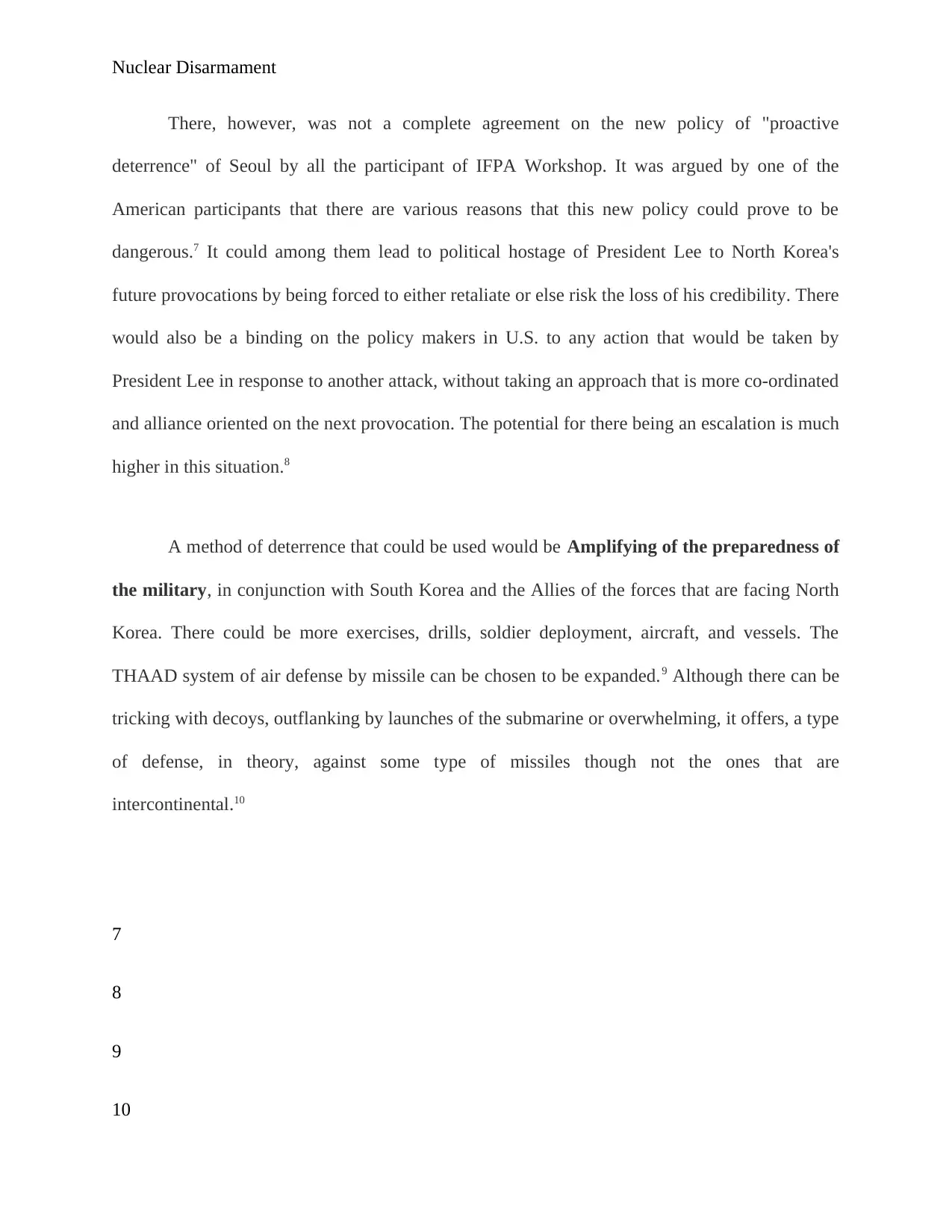
Nuclear Disarmament
There, however, was not a complete agreement on the new policy of "proactive
deterrence" of Seoul by all the participant of IFPA Workshop. It was argued by one of the
American participants that there are various reasons that this new policy could prove to be
dangerous.7 It could among them lead to political hostage of President Lee to North Korea's
future provocations by being forced to either retaliate or else risk the loss of his credibility. There
would also be a binding on the policy makers in U.S. to any action that would be taken by
President Lee in response to another attack, without taking an approach that is more co-ordinated
and alliance oriented on the next provocation. The potential for there being an escalation is much
higher in this situation.8
A method of deterrence that could be used would be Amplifying of the preparedness of
the military, in conjunction with South Korea and the Allies of the forces that are facing North
Korea. There could be more exercises, drills, soldier deployment, aircraft, and vessels. The
THAAD system of air defense by missile can be chosen to be expanded.9 Although there can be
tricking with decoys, outflanking by launches of the submarine or overwhelming, it offers, a type
of defense, in theory, against some type of missiles though not the ones that are
intercontinental.10
7
8
9
10
There, however, was not a complete agreement on the new policy of "proactive
deterrence" of Seoul by all the participant of IFPA Workshop. It was argued by one of the
American participants that there are various reasons that this new policy could prove to be
dangerous.7 It could among them lead to political hostage of President Lee to North Korea's
future provocations by being forced to either retaliate or else risk the loss of his credibility. There
would also be a binding on the policy makers in U.S. to any action that would be taken by
President Lee in response to another attack, without taking an approach that is more co-ordinated
and alliance oriented on the next provocation. The potential for there being an escalation is much
higher in this situation.8
A method of deterrence that could be used would be Amplifying of the preparedness of
the military, in conjunction with South Korea and the Allies of the forces that are facing North
Korea. There could be more exercises, drills, soldier deployment, aircraft, and vessels. The
THAAD system of air defense by missile can be chosen to be expanded.9 Although there can be
tricking with decoys, outflanking by launches of the submarine or overwhelming, it offers, a type
of defense, in theory, against some type of missiles though not the ones that are
intercontinental.10
7
8
9
10
Paraphrase This Document
Need a fresh take? Get an instant paraphrase of this document with our AI Paraphraser
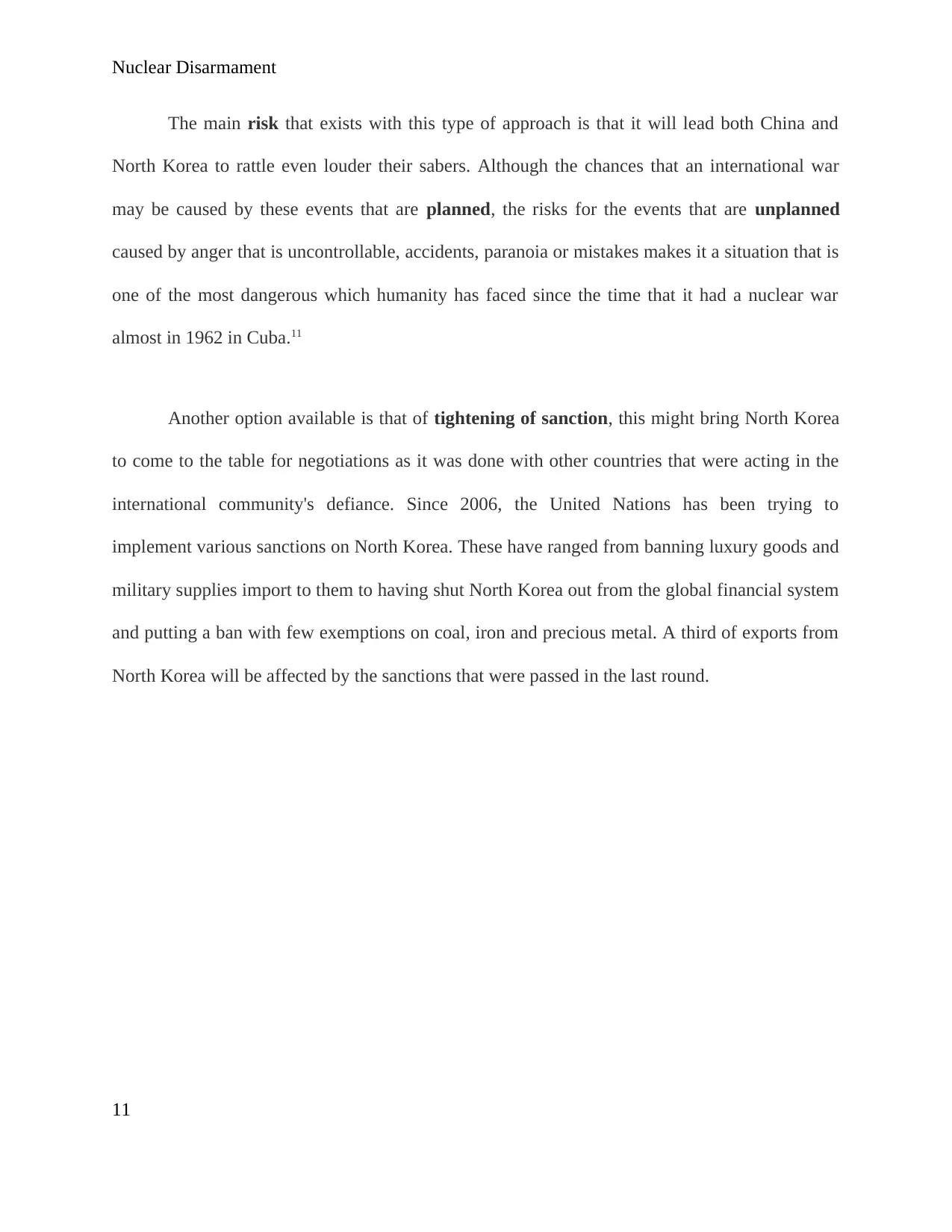
Nuclear Disarmament
The main risk that exists with this type of approach is that it will lead both China and
North Korea to rattle even louder their sabers. Although the chances that an international war
may be caused by these events that are planned, the risks for the events that are unplanned
caused by anger that is uncontrollable, accidents, paranoia or mistakes makes it a situation that is
one of the most dangerous which humanity has faced since the time that it had a nuclear war
almost in 1962 in Cuba.11
Another option available is that of tightening of sanction, this might bring North Korea
to come to the table for negotiations as it was done with other countries that were acting in the
international community's defiance. Since 2006, the United Nations has been trying to
implement various sanctions on North Korea. These have ranged from banning luxury goods and
military supplies import to them to having shut North Korea out from the global financial system
and putting a ban with few exemptions on coal, iron and precious metal. A third of exports from
North Korea will be affected by the sanctions that were passed in the last round.
11
The main risk that exists with this type of approach is that it will lead both China and
North Korea to rattle even louder their sabers. Although the chances that an international war
may be caused by these events that are planned, the risks for the events that are unplanned
caused by anger that is uncontrollable, accidents, paranoia or mistakes makes it a situation that is
one of the most dangerous which humanity has faced since the time that it had a nuclear war
almost in 1962 in Cuba.11
Another option available is that of tightening of sanction, this might bring North Korea
to come to the table for negotiations as it was done with other countries that were acting in the
international community's defiance. Since 2006, the United Nations has been trying to
implement various sanctions on North Korea. These have ranged from banning luxury goods and
military supplies import to them to having shut North Korea out from the global financial system
and putting a ban with few exemptions on coal, iron and precious metal. A third of exports from
North Korea will be affected by the sanctions that were passed in the last round.
11
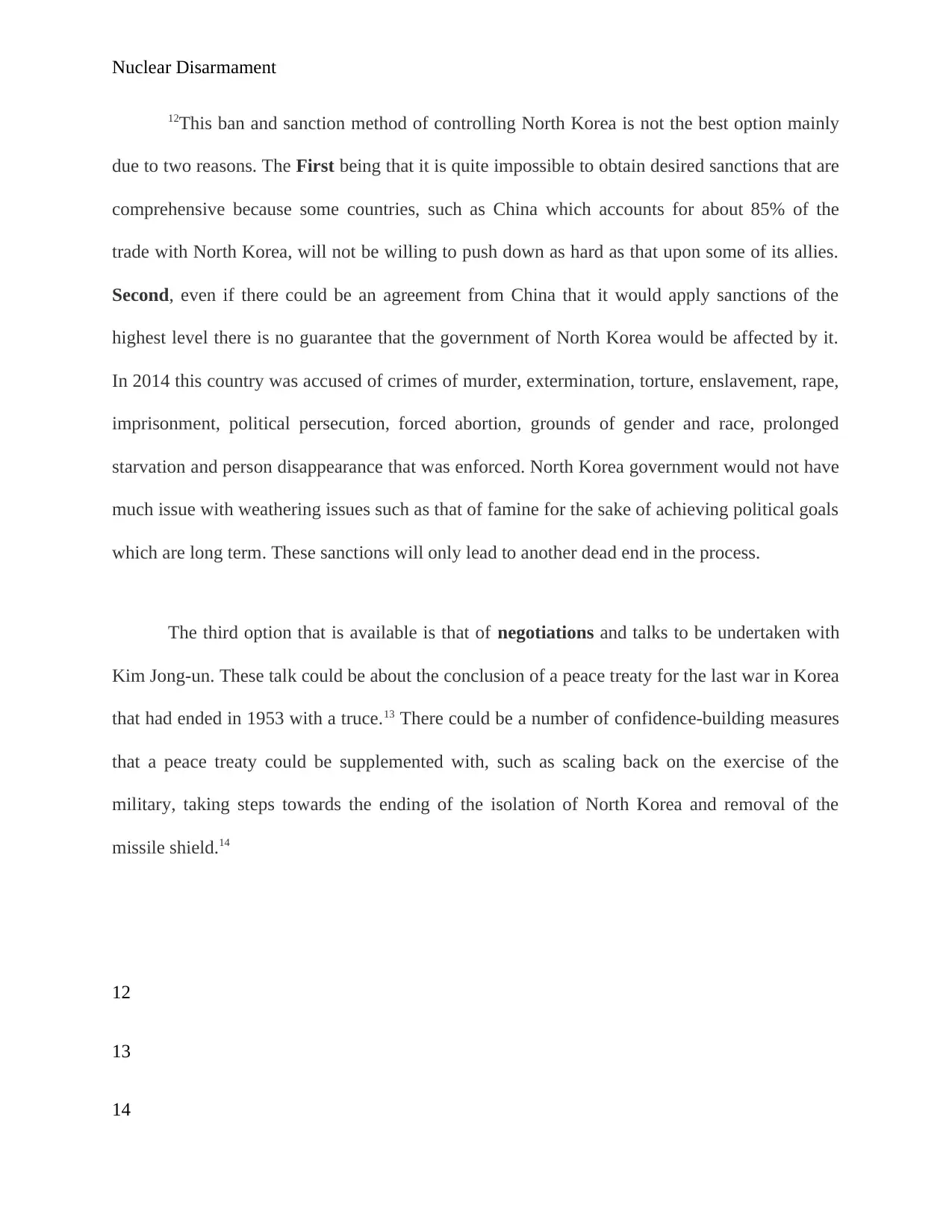
Nuclear Disarmament
12This ban and sanction method of controlling North Korea is not the best option mainly
due to two reasons. The First being that it is quite impossible to obtain desired sanctions that are
comprehensive because some countries, such as China which accounts for about 85% of the
trade with North Korea, will not be willing to push down as hard as that upon some of its allies.
Second, even if there could be an agreement from China that it would apply sanctions of the
highest level there is no guarantee that the government of North Korea would be affected by it.
In 2014 this country was accused of crimes of murder, extermination, torture, enslavement, rape,
imprisonment, political persecution, forced abortion, grounds of gender and race, prolonged
starvation and person disappearance that was enforced. North Korea government would not have
much issue with weathering issues such as that of famine for the sake of achieving political goals
which are long term. These sanctions will only lead to another dead end in the process.
The third option that is available is that of negotiations and talks to be undertaken with
Kim Jong-un. These talk could be about the conclusion of a peace treaty for the last war in Korea
that had ended in 1953 with a truce.13 There could be a number of confidence-building measures
that a peace treaty could be supplemented with, such as scaling back on the exercise of the
military, taking steps towards the ending of the isolation of North Korea and removal of the
missile shield.14
12
13
14
12This ban and sanction method of controlling North Korea is not the best option mainly
due to two reasons. The First being that it is quite impossible to obtain desired sanctions that are
comprehensive because some countries, such as China which accounts for about 85% of the
trade with North Korea, will not be willing to push down as hard as that upon some of its allies.
Second, even if there could be an agreement from China that it would apply sanctions of the
highest level there is no guarantee that the government of North Korea would be affected by it.
In 2014 this country was accused of crimes of murder, extermination, torture, enslavement, rape,
imprisonment, political persecution, forced abortion, grounds of gender and race, prolonged
starvation and person disappearance that was enforced. North Korea government would not have
much issue with weathering issues such as that of famine for the sake of achieving political goals
which are long term. These sanctions will only lead to another dead end in the process.
The third option that is available is that of negotiations and talks to be undertaken with
Kim Jong-un. These talk could be about the conclusion of a peace treaty for the last war in Korea
that had ended in 1953 with a truce.13 There could be a number of confidence-building measures
that a peace treaty could be supplemented with, such as scaling back on the exercise of the
military, taking steps towards the ending of the isolation of North Korea and removal of the
missile shield.14
12
13
14
⊘ This is a preview!⊘
Do you want full access?
Subscribe today to unlock all pages.

Trusted by 1+ million students worldwide
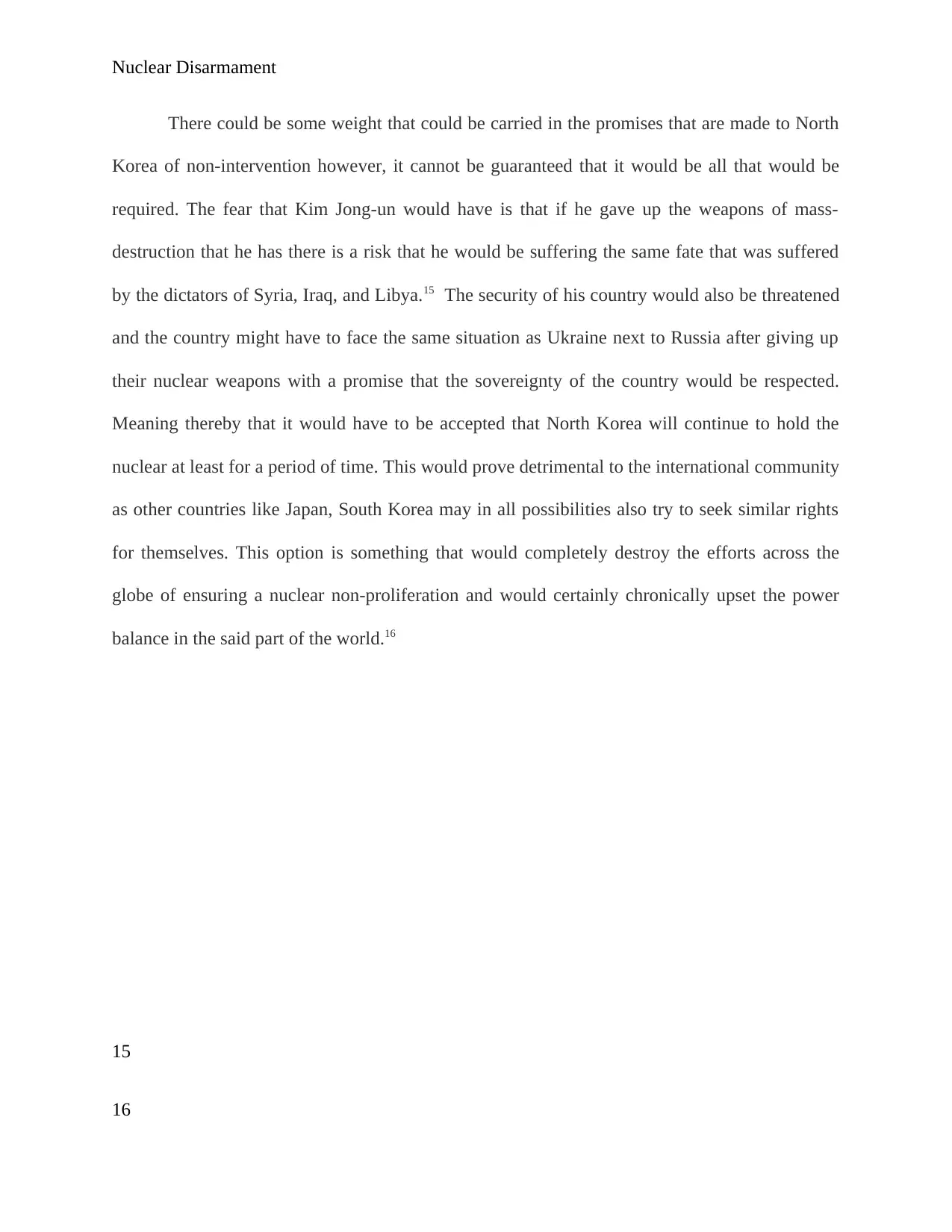
Nuclear Disarmament
There could be some weight that could be carried in the promises that are made to North
Korea of non-intervention however, it cannot be guaranteed that it would be all that would be
required. The fear that Kim Jong-un would have is that if he gave up the weapons of mass-
destruction that he has there is a risk that he would be suffering the same fate that was suffered
by the dictators of Syria, Iraq, and Libya.15 The security of his country would also be threatened
and the country might have to face the same situation as Ukraine next to Russia after giving up
their nuclear weapons with a promise that the sovereignty of the country would be respected.
Meaning thereby that it would have to be accepted that North Korea will continue to hold the
nuclear at least for a period of time. This would prove detrimental to the international community
as other countries like Japan, South Korea may in all possibilities also try to seek similar rights
for themselves. This option is something that would completely destroy the efforts across the
globe of ensuring a nuclear non-proliferation and would certainly chronically upset the power
balance in the said part of the world.16
15
16
There could be some weight that could be carried in the promises that are made to North
Korea of non-intervention however, it cannot be guaranteed that it would be all that would be
required. The fear that Kim Jong-un would have is that if he gave up the weapons of mass-
destruction that he has there is a risk that he would be suffering the same fate that was suffered
by the dictators of Syria, Iraq, and Libya.15 The security of his country would also be threatened
and the country might have to face the same situation as Ukraine next to Russia after giving up
their nuclear weapons with a promise that the sovereignty of the country would be respected.
Meaning thereby that it would have to be accepted that North Korea will continue to hold the
nuclear at least for a period of time. This would prove detrimental to the international community
as other countries like Japan, South Korea may in all possibilities also try to seek similar rights
for themselves. This option is something that would completely destroy the efforts across the
globe of ensuring a nuclear non-proliferation and would certainly chronically upset the power
balance in the said part of the world.16
15
16
Paraphrase This Document
Need a fresh take? Get an instant paraphrase of this document with our AI Paraphraser
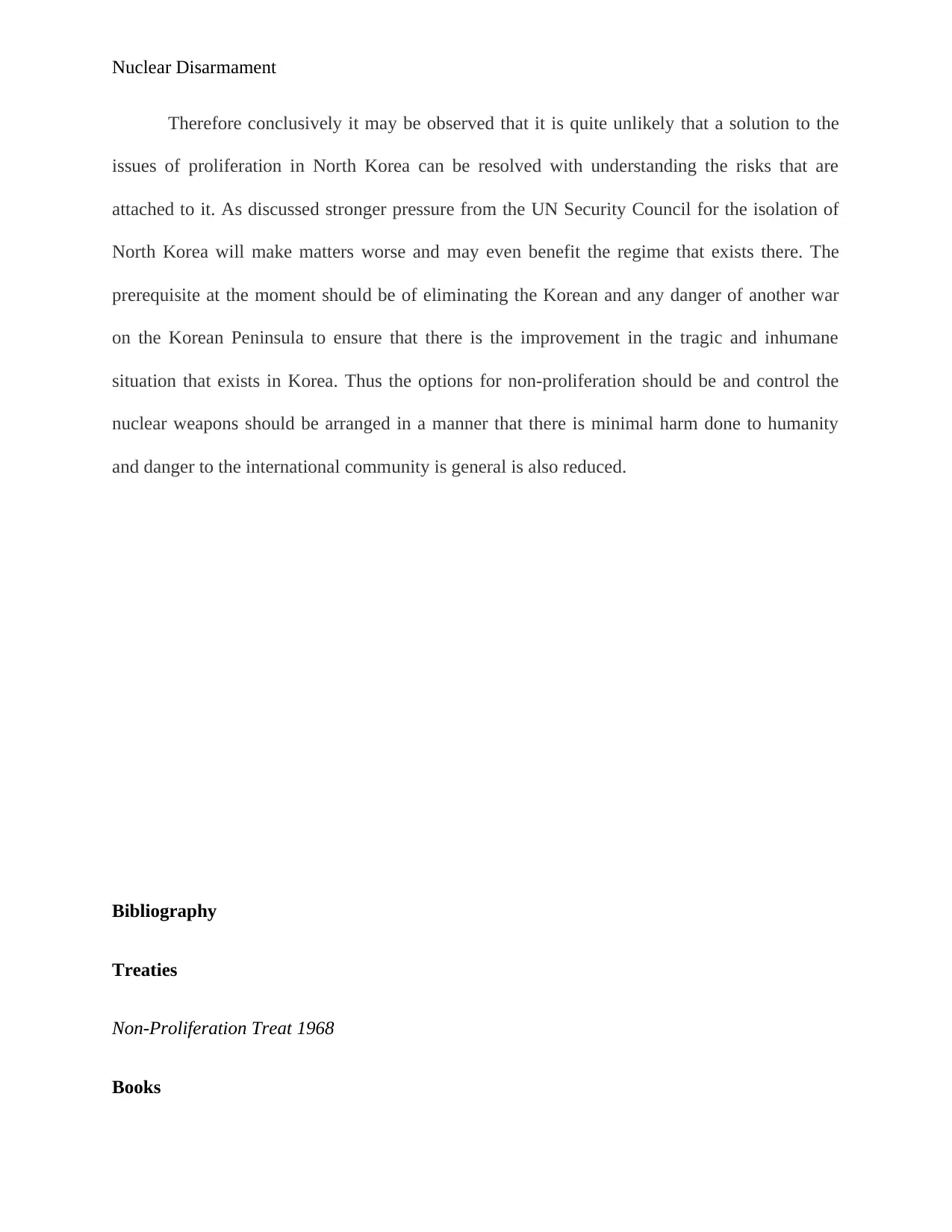
Nuclear Disarmament
Therefore conclusively it may be observed that it is quite unlikely that a solution to the
issues of proliferation in North Korea can be resolved with understanding the risks that are
attached to it. As discussed stronger pressure from the UN Security Council for the isolation of
North Korea will make matters worse and may even benefit the regime that exists there. The
prerequisite at the moment should be of eliminating the Korean and any danger of another war
on the Korean Peninsula to ensure that there is the improvement in the tragic and inhumane
situation that exists in Korea. Thus the options for non-proliferation should be and control the
nuclear weapons should be arranged in a manner that there is minimal harm done to humanity
and danger to the international community is general is also reduced.
Bibliography
Treaties
Non-Proliferation Treat 1968
Books
Therefore conclusively it may be observed that it is quite unlikely that a solution to the
issues of proliferation in North Korea can be resolved with understanding the risks that are
attached to it. As discussed stronger pressure from the UN Security Council for the isolation of
North Korea will make matters worse and may even benefit the regime that exists there. The
prerequisite at the moment should be of eliminating the Korean and any danger of another war
on the Korean Peninsula to ensure that there is the improvement in the tragic and inhumane
situation that exists in Korea. Thus the options for non-proliferation should be and control the
nuclear weapons should be arranged in a manner that there is minimal harm done to humanity
and danger to the international community is general is also reduced.
Bibliography
Treaties
Non-Proliferation Treat 1968
Books
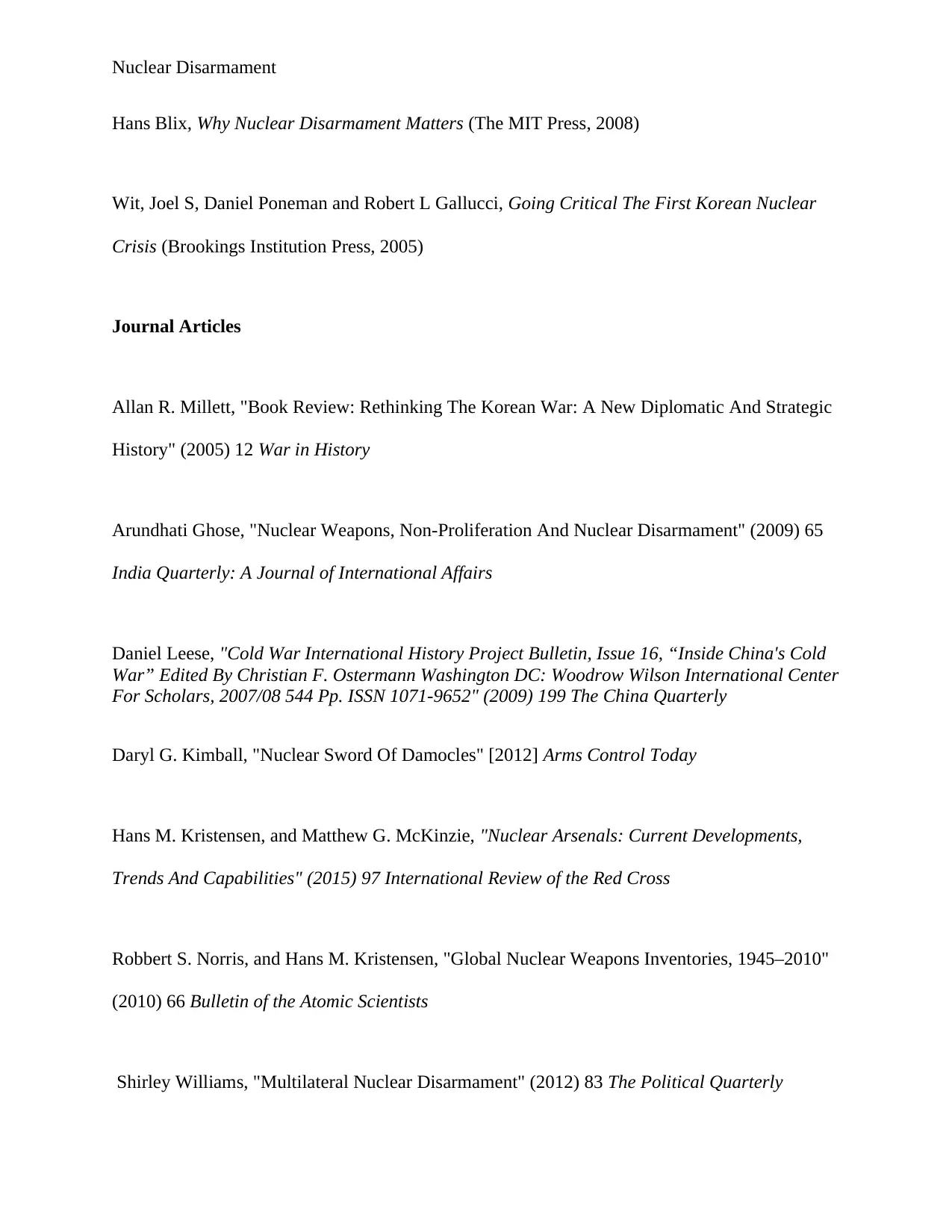
Nuclear Disarmament
Hans Blix, Why Nuclear Disarmament Matters (The MIT Press, 2008)
Wit, Joel S, Daniel Poneman and Robert L Gallucci, Going Critical The First Korean Nuclear
Crisis (Brookings Institution Press, 2005)
Journal Articles
Allan R. Millett, "Book Review: Rethinking The Korean War: A New Diplomatic And Strategic
History" (2005) 12 War in History
Arundhati Ghose, "Nuclear Weapons, Non-Proliferation And Nuclear Disarmament" (2009) 65
India Quarterly: A Journal of International Affairs
Daniel Leese, "Cold War International History Project Bulletin, Issue 16, “Inside China's Cold
War” Edited By Christian F. Ostermann Washington DC: Woodrow Wilson International Center
For Scholars, 2007/08 544 Pp. ISSN 1071-9652" (2009) 199 The China Quarterly
Daryl G. Kimball, "Nuclear Sword Of Damocles" [2012] Arms Control Today
Hans M. Kristensen, and Matthew G. McKinzie, "Nuclear Arsenals: Current Developments,
Trends And Capabilities" (2015) 97 International Review of the Red Cross
Robbert S. Norris, and Hans M. Kristensen, "Global Nuclear Weapons Inventories, 1945–2010"
(2010) 66 Bulletin of the Atomic Scientists
Shirley Williams, "Multilateral Nuclear Disarmament" (2012) 83 The Political Quarterly
Hans Blix, Why Nuclear Disarmament Matters (The MIT Press, 2008)
Wit, Joel S, Daniel Poneman and Robert L Gallucci, Going Critical The First Korean Nuclear
Crisis (Brookings Institution Press, 2005)
Journal Articles
Allan R. Millett, "Book Review: Rethinking The Korean War: A New Diplomatic And Strategic
History" (2005) 12 War in History
Arundhati Ghose, "Nuclear Weapons, Non-Proliferation And Nuclear Disarmament" (2009) 65
India Quarterly: A Journal of International Affairs
Daniel Leese, "Cold War International History Project Bulletin, Issue 16, “Inside China's Cold
War” Edited By Christian F. Ostermann Washington DC: Woodrow Wilson International Center
For Scholars, 2007/08 544 Pp. ISSN 1071-9652" (2009) 199 The China Quarterly
Daryl G. Kimball, "Nuclear Sword Of Damocles" [2012] Arms Control Today
Hans M. Kristensen, and Matthew G. McKinzie, "Nuclear Arsenals: Current Developments,
Trends And Capabilities" (2015) 97 International Review of the Red Cross
Robbert S. Norris, and Hans M. Kristensen, "Global Nuclear Weapons Inventories, 1945–2010"
(2010) 66 Bulletin of the Atomic Scientists
Shirley Williams, "Multilateral Nuclear Disarmament" (2012) 83 The Political Quarterly
⊘ This is a preview!⊘
Do you want full access?
Subscribe today to unlock all pages.

Trusted by 1+ million students worldwide
1 out of 9
Related Documents
Your All-in-One AI-Powered Toolkit for Academic Success.
+13062052269
info@desklib.com
Available 24*7 on WhatsApp / Email
![[object Object]](/_next/static/media/star-bottom.7253800d.svg)
Unlock your academic potential
Copyright © 2020–2025 A2Z Services. All Rights Reserved. Developed and managed by ZUCOL.



